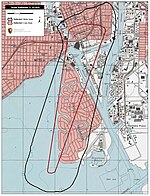Harbour Island (Tampa)
Neighborhoods in Tampa, FloridaPlanned communities in Florida
Harbour Island is an island neighborhood within the city limits of Tampa, Florida and the sub-district within Downtown Tampa. The ZIP Code serving the area is 33602.
Excerpt from the Wikipedia article Harbour Island (Tampa) (License: CC BY-SA 3.0, Authors).Harbour Island (Tampa)
South Harbour Island Boulevard, Tampa Harbour Island
Geographical coordinates (GPS) Address Nearby Places Show on map
Geographical coordinates (GPS)
| Latitude | Longitude |
|---|---|
| N 27.937222222222 ° | E -82.453333333333 ° |
Address
South Harbour Island Boulevard
South Harbour Island Boulevard
33602 Tampa, Harbour Island
Florida, United States
Open on Google Maps









